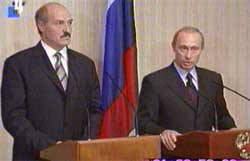
ENERGY DILEMMA FOR BELARUS
Publication: Eurasia Daily Monitor Volume: 3 Issue: 25
By:

On January 24, Belarusian President Alexander Lukashenka met with Russian President Vladimir Putin at the Constantine Palace near St Petersburg prior to a session of the Russian-Belarusian Supreme State Council. Lukashenka remarked that the integration process between the two states had taken on an irreversible character and that the two sides are close strategic partners. His statements masked an acute economic dilemma for the Belarusian side, namely the dependence of Belarus on Russia for supplies of natural gas that compose 80% of its fuel needs and the fact that 99% of Belarus’ imported energy resources are purchased from Russia at a cost of over $1.5 billion annually.
Energy is the Achilles heel of the Lukashenka administration. On December 27, the two countries signed a contract for the supply and transit of gas in 2006, according to which Russia’s Gazprom will supply to Belarus 21 billion cubic meters of gas at a price of $46.68 per 1,000 cubic meters, four to five times lower than the world price level. Several Russian outlets have speculated that the price for such apparent benevolence on Russia’s part is the eventual transfer of the Belarusian gas transport enterprise — Beltransgaz — to Russian ownership. Gazprom has made it clear that the low price will remain in place for 2006 only, and reflects the creation of a Union state that will mean single standards for the financial and economic indices of the two states.
Russia also wishes to ensure reliable supplies of gas to Europe. In 2005, Russia exported 40.4 billion cubic meters of gas through Belarus, of which 21.7 billion was dispatched along the Yamal-Europe line. Last year Gazprom took control of this route, which transports over half of the Russian gas supplied for export through Belarus. Though negotiations for Russian control of Beltransgaz have been protracted, Gazprom Deputy Chair Alexander Medvedev has suggested that the decisive period will be the next two to three months. In late January Russia and Belarus signed an agreement on “fuel-energy balance” through 2020, which anticipates that Belarus will increase imports of gas from Russia from 21 billion to 26 billion cubic meters per year.
In August 2005, President Lukashenka approved the Conception of Energy Security and Increased Energy Independence of Belarus in 2006-2010, which provides a more accurate reflection of how the Belarusian authorities perceive the current energy imbalance and dependence on Russia. The emphasis is clear. Over this period all conditions must be in place to start construction on a nuclear power station in Belarus. Though the authorities are careful to stress that plans remain on paper — a 10-year moratorium on construction of a Belarusian nuclear plant ends only in 2008 — there is ample evidence that the government perceives nuclear energy as the only means out of the impasse.
Thus Academician Alexander Mikhalevich, who heads the Center for Energy Effectiveness with the Institute of Thermal and Mass Exchanges, states that the current dependence on natural gas is highly dangerous, with gas prices anticipated to rise by four times in the future If an accident were to occur on the pipelines from Russia, Belarus would be thrown into a catastrophic situation. Supplies of gas in the long-term are not guaranteed. First Deputy Prime Minister Uladzimir Semashka informed the 10th Belarusian Energy and Ecological Congress last October that by 2009-2010 it may no longer be expedient for Belarus to rely on natural gas as its primary energy source.
How will Belarus switch to the nuclear alternative? At a press conference on January 23, Mikhalevich commented that work on a nuclear plant could not begin before 2008 because of the need to resolve problems related to the burial of radioactive waste and construction. He cited the Russian VVER-640 and VVER-1000 (third generation water-pressurized) reactors as the likely prototypes for Belarus (earlier debates have focused on more expensive Western designs, such as Westinghouse). The ideal capacity for a nuclear plant is 2,000 megawatts, which would allow potential reliance on nuclear power for 27% of Belarus’ electricity output. The station would likely be constructed in Mahileu region and two possible locations have already been suggested.
In January, Lukashenka stressed that a nuclear plant is essential for Belarus, and he dismissed fears of accidents and an implied phobia about nuclear power as a result of the 1986 disaster at Chernobyl by noting that the country is already “surrounded” by nuclear plants — Ignalina (Lithuania), Chernobyl, and Smolensk (Russia) — all of which are located close to the Belarusian border. However, an earlier attempt — the building of a nuclear power and heating station near Minsk that began in 1983 — was abandoned after the Chernobyl accident and public fears are far from assuaged.
The agreement with Gazprom thus avoided the sort of impasse that occurred between Russia and Ukraine; but over the long term, Belarus faces a critical energy dilemma. Ironically, however, if the projected nuclear plant requires Russian technology, the dependence on the partner country will continue. How long the “Belarusian economic model” continues to thrive is thus debatable, but it is a path fraught with potential pitfalls.
(Belarusy i rynok, January 16, 23, 30; SB Belarus’ Segodnya, January 31; BDG Delovaya gazeta, January 3)




